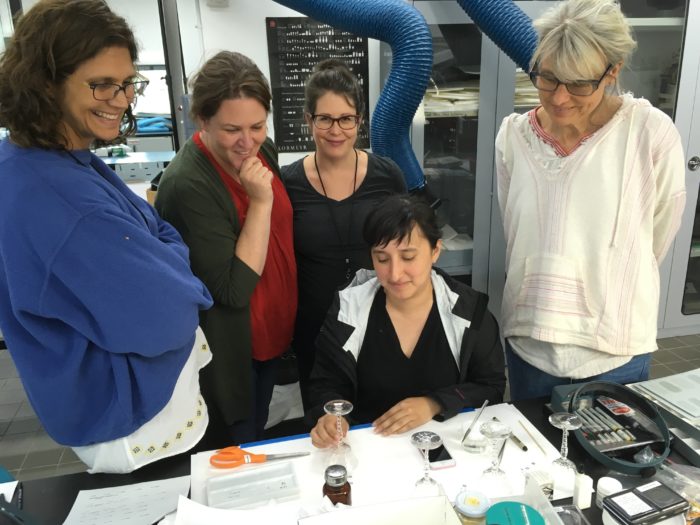This post was written by guest authors Martha Singer, Mette Carlsen, Jakki Godfrey, and Kerith Koss Schrager, a team of contract conservators who carried out Cooper Hewitt’s recent glass rehousing project.
Today we’re taking a behind-the-scenes look at the nitty-gritty of object numbering in the museum. Object numbers aid in tracking storage locations and other data for the works in Cooper Hewitt’s expansive collection, an essential step in ensuring the collection’s long-term preservation. However, given the large number of collection objects, numbering all objects clearly can be challenging.
Each object in the collection is assigned a unique number once it is acquired by the museum, known as an accession number. This number is in most cases written directly on the object, or in some cases on an acid-free tag that is attached to the object with a cotton string. Glass objects present a special challenge because the number can often be seen and may be distracting when the object is on display. Cooper Hewitt has adopted several labeling approaches throughout the glass collection’s history: red, black, or white numbers have been hand-painted directly on the glass, sometimes between layers of adhesive coating. Alternately, paper tags with barcodes and numbers are placed nearby, or tied to the objects (note that adhesive labels are not preferred for museum objects). In general, today we avoid painting accession numbers directly on collection objects without a barrier of some sort, to prevent surface damage and also improve the label’s longevity.
Over time, some numbers have partially worn off of older objects, eventually becoming illegible, and some new additions to the collection have not yet been labeled directly. A Collections Care and Preservation Fund Grant for improving the storage of the glass collection created an opportunity to investigate the best method of numbering for these glass objects. Four senior objects conservators working on the storage project considered a variety of options, and worked with the Product Design and Decorative Arts Collections Manager to find the best method.

Contract conservators Martha Singer, Kerith Koss Schrager, Jakki Godfrey, and Mette Carlsen worked with Collections Manager Crystal Ferrer to research the best methods for glass numbering.
Research focused on improving the original numbering approaches, and the team tested various ways to identify the glass objects with handwritten or laser-printed labels. One novel proposed solution would use a special ink that would fluoresce when exposed to ultra-violet light, but would otherwise remain invisible under normal lighting. This proposal was discarded as too impractical, as the number would be hard to determine when the object was in storage under normal lighting conditions.
An important credo in conservation is that any treatment performed on an artwork or object should be reversible. Accordingly, the identifying numbers were sandwiched between two layers of adhesive (in this case B-72, an acrylic resin that can be dissolved in acetone, is chemically stable, and does not yellow over time). With this approach, the labels could be easily removed at any time without damaging the object.
For laser-printed labels, it was important to select a font in which the numbers zero and one are distinct from the upper-case letters “O” and lowercase “l”. Tests also included printing the labels on various types of materials commonly used in conservation (special conservation papers made in Japan and plastic film known as Mylar®), paying attention to whether the toner diffused or remained stable in the paper and how the laser printer handled them depending on thickness. For hand-printed labels, various types of pens were tested.

A small group of wine glasses served as test cases, with similar surfaces to compare various numbering methods.
The tests revealed that handwritten labels can work well depending on the skill of the person writing the numbers (if legible, many letters and numbers can be confused for others). However, hand-writing the labels is time consuming, the resulting labels tend to be larger than laser-printed labels, and there is potential for human error in transcribing numbers. In contrast, laser-printed labels are faster to print from the collections database, allow for much smaller text, and, with the proper procedure, can be error free. The Mylar was least visible and the Japanese paper conformed best to surfaces that are not flat– we will now implement both methods as we label new objects.

Labeling methods for glass are compared on these two glasses. Clear Mylar film, Tengujo Japanese paper, and handwritten labels are applied over a B72 barrier layer.
Looking toward the future, our Conservators and Collections Managers will continue to explore different solutions for tricky labeling dilemmas. We are delighted that this new method of labeling objects will increase both efficiency and clarity!
References
Braun, Thomas J. “An Alternative Technique for Applying Accession Numbers to Museum Artifacts,” Journal of the American Institute for Conservation 46, no. 2 (2007) : 91–104.
Williams, Roger S. Optically Cleared Repair Tissues for the Treatment of Translucent Papers. Book and Paper Group Annual 37 (2018): 96–112.
MATERIALS
For more information about the Sakura pens for hand labeling, see the entry on preserv’art (a resource by the Centre de conservation Québec).
For printed labels, our preferred Japanese Tissue was Tengujo (18gsm).